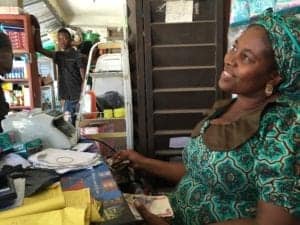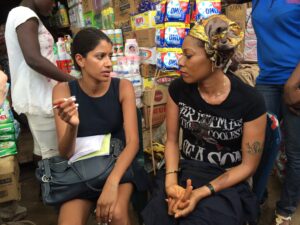Women-led enterprises are typically unserved by financial service providers because they either don’t realize the huge market opportunity it presents or they don’t know how. Reaching this segment requires a thorough understanding of their needs and products specifically designed to meet them. Change management is crucial to successfully implement the massive transformation in operations required to effectively serve women.
Millions of micro, small, and medium enterprises (MSMEs) in Sub-Saharan Africa lack access to formal financial services – and institutions often struggle to understand and meet their needs. Despite the challenges, the MSME market presents a large and relatively untapped opportunity for financial service providers. Female-run enterprises in particular, are largely unserved: IFC estimates 70% of women-led SMEs across the globe are un- or underserved.
Women-led enterprises range from the micro level—home-based or petty trade businesses, family-run micro-enterprises, or established microenterprises with more formal structures and employees—to registered small enterprises with salaried employees. But to reach these entrepreneurs, institutions need to understand their needs. Small-scale product adaptations or staff trainings aren’t enough.

Over the past several years, Women’s World Banking has worked with KCB Bank in Kenya and Diamond Bank in Nigeria to implement change management to better serve women-led MSMEs. The lessons from this work provide insights for other institutions to reach women in this market segment.
Bridging the Gap Between Institutions and MSMEs
KCB Bank and Diamond Bank both faced institutional challenges in serving women-led MSMEs. Many obstacles derived from the gap between the institution’s understanding of and offerings to MSMEs and what women-owned MSMEs need and want. For example, a 2017 banking industry survey of 3,500 Nigerian SMEs showed that only 3 in 10 were satisfied with their bank’s knowledge of their business.
This lack of a common understanding of the MSME segment and their needs, the lack of a comprehensive customer profile and the limited amount of business support or value-added services available to this market is a challenge experienced not just by these two institutions, but by many in the industry.
 Many women are cautious about borrowing from a financial institution for various reasons, including providing collateral, turnover, processing time, and perceived risk along with lack of information about procedures. According to a? woman entrepreneur, “they should introduce an easier way to source funds for your business. Of course we would be interested if all these barriers were settled.”
Many women are cautious about borrowing from a financial institution for various reasons, including providing collateral, turnover, processing time, and perceived risk along with lack of information about procedures. According to a? woman entrepreneur, “they should introduce an easier way to source funds for your business. Of course we would be interested if all these barriers were settled.”
Ultimately, women-led MSMEs want privacy and confidentiality, respect, clear and fast processes, and transparency. What do banks need to do to deliver on these opportunities?
Implementing Change Across the Organization
Innovation in lending requires change management. In other words, building internal support and implementing behavior change across the entire institution. This included introducing a relationship management model, adding a gender focus to the strategy and staff training, revising the credit methodology, and introducing key customer relationship management system enhancements. KCB Bank also implemented a blended learning program that combines classroom training with practical application. But change management isn’t easy. There can be internal resistance to new approaches. Aversion to risk, entropy, and the desire to stick to the status quo can hamper change.

The Women’s World Banking change management approach addresses the institutional barriers to change in a number of ways. First, by developing a strong business case: developing a financial model that projects investment and returns aligns senior management on expectations.
Women’s World Banking hosts exposure visits of senior leadership to institutions in other countries that have successfully implemented changes, a powerful tool that demonstrates the changes in action and operating successfully.
Women’s World Banking also embeds a project team at the partner bank to provide the capacity needed to implement these changes and channel clear, continuous internal communication among all stakeholders.
And last but not least, Women’s World Banking provides capacity-building through training staff across all levels, to enable the institution to execute the shift beyond the lifetime of Women’s World Banking’s engagement.
Three lessons in enabling better service to MSMEs
Working with KCB Bank and Diamond Bank surfaced a number of lessons on how banks can change to better serve MSMEs.
A gender-inclusive focus is crucial. Providing gender training and implementation tools such as sales scripts are simple but effective enablers of better service to women clients.

Large businesses have personals bankers – why not MSMEs? At Diamond Bank, Women’s World Banking introduced a Lending Officer model that includes training and coaching staff enhances how bankers interact with clients. At KCB Bank, Women’s World Banking introduced the relationship management model that allows staff to have 360 degree view of the customer’s business and needs.
Third, having an internal champion that drives this shift is absolutely necessary to navigate the challenges and advocate for the initiative success, for instance, by ensuring that lending is prioritized above other institutional targets.
Improved Product Performance and Customer Experience
Women’s World Banking’s experience with Diamond Bank and KCB Bank has shown that change management, prioritization of goals and products, and a gender-inclusive focus are all necessary to serve the MSME segment well. Investing in change management has paid off. Diamond Bank’s program has outperformed all targets set for December 2018 by July 2018 largely because of the credit risk department’s move away from criteria that made it hard for women to get loans (collateral and account turnover) and instead adopted the cash flow lending methodology. KCB Bank’s customer satisfaction score improved from 73% to 81% and most impressively, increased the number of women it was reaching from 9% to 49% in 2018.
Women’s World Banking looks forward to continuing to support both institutions to build on their success and further their reach into the women-led MSME segment in their market and leverage these learnings to enable other financial service providers to tap this incredible market opportunity in their respective countries.
Women’s World Banking’s work was supported by UK aid from the British People and The Argidius Foundation.




